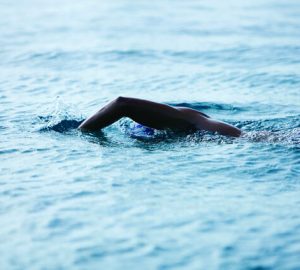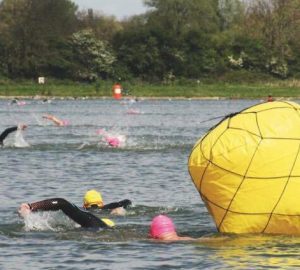Mindful practice makes perfect
How do you describe your pool activity? Do you do a workout, or a practice? From my teens to early 40s, I did workouts, but for the past 25 years I’ve exclusively referred to swim training as practice, and encouraged others to think the same way.
This choice reflects the central intention I bring to my training, and is more closely related to the practice of meditation than, say, practising a tennis serve. At the same time, my practice is always focused on actions which will improve my performance in an open water event, whether it’s a 1.5km race or a marathon.
George Leonard, author of the book Mastery: The Keys to Success and Long-Term Fulfillment defines practice as: “a set of complementary activities, done with consistency, to create enduring positive change in body, mind, and spirit.” Over the next few issues of H2Open, I’ll be making the case for swimming as a practice, and offer suggestions for making that transition from seeing what you do in the pool primarily as a workout.
I’m confident that adopting a practice orientation will help you swim better and enjoy it more. What’s not to like? While workouts are designed mainly to accumulate totals of metres and heartbeats, a swimming practice is explicitly intended to improve your swimming. Your goal is always to Be a Better Swimmer at the end of practice. By doing so, you also create salutary effects on brain and psyche.
The foundational element in developing a swimming practice mentality is the Stroke Thought (in Total Immersion, we refer to these as Focal Points). Start by resolving to begin every lap, repeat, or set with a specific Stroke Thought. Your Stroke Thought should be laser-targeted on a narrow aspect of technique. You might also want to think of this as Mindful Swimming.
While swimming and holding your Stroke Thought, your goals are to improve that aspect of technique; develop awareness or self-perception; and increase your capacity for undistracted focus.
When introducing swimmers to Mindful Swimming, I recommend that after each repeat they assess both their quality of movement and their quality of attention. Improving the latter is essential to improving the former.
Everyone who meditates has experienced what Buddhists call ‘monkey mind.’ You begin with the intent to focus on your breath and find yourself distracted by other thoughts. When this occurs, you’re told, just return attention to your breath. Each hour of practice slightly improves your ability to maintain undistracted focus.
Quietening the mind is challenging for anyone, but even more for swimmers: the repetitive nature of workouts encourages us to find distractions from the perceived tedium. There’s also the tendency to ‘follow the black line’ or, in a group workout, the feet ahead of you. But the essentially solitary nature of swimming – even in a crowded pool – and the way the water envelops us in a ‘cocoon’ of kinesthetic sensation, makes swimming ideal for a mindful approach, and for strengthening one’s focus.
Mindful Swimming: A Starter Practice
In the following series of Stroke Thoughts, each set of three addresses a different body part and aspect of technique. Each Stroke Thought in a set stimulates the brain in a different way; combining them is especially powerful.
Balance Thoughts are intended to create a sense of weightlessness and support, increase comfort, and calm the mind. Total Immersion technique work always starts with Balance Thoughts.
A.
Hang your head: Relax neck and back muscles to completely release your head’s weight to the water.
B.
Rest your head: Tune in to the water’s density. Feel that it cushions your face and head. Rest your head fully upon that cushion.
C.
Be pulled forward: Imagine there’s a line attached to the crown of your head. Feel it pull your head and spine directly forward.
Streamline Thoughts minimise drag and turbulence as you stroke allowing you to swim any distance or speed with less effort.
A.
Swim ‘taller’: Swim as if the most important role for your arms is to extend your bodyline in each stroke, not to push back on the water.
B.
Swim ‘quieter’: Do whatever it takes to eliminate noise, splash and bubbles from your stroke.
C.
Cut a sleeve: As you enter each hand, visualize that you’re cutting a ‘sleeve’ in the water with your extending arm. Align that side of your body to slip through the sleeve.
Propulsion Thoughts should connect arms and legs to the rhythms and power of the core and align with natural forces: gravity and buoyancy. This group improves the efficiency of your kick.
A. Calm your legs: Reduce the size, speed, and effort of your kick.
B.
Steady pressure: Feel the water pressure around your feet and legs as firm and steady. Also kick more quietly.
C.
In the stream: Visualise a slipstream behind your upper body. Keep your legs within it.
Design a Practice Set
My favourite base set for Mindful Swimming is:
• 4 x 25m
• 3 x 50m
• 2 x 75m
• 1 x 100m
For each group of thoughts, swim the full set of repeats with Stroke Thought A, then repeat for B and C. Maintaining focus for an additional length will be more demanding. Use shorter repeats to strengthen attention for longer ones.
After 1000 to 1500 metres of concentrated practice of one Stroke Thought at a time, practise sequencing and blending them. This accelerates the process of moving the associated skill from conscious to autonomic control, and encoding in muscle memory.
Sequence Set
Swim 4 rounds of 3x75m as 25m of A, 25m of B and 25m of C.
Blending Set
Swim 3 rounds of 3 x 50m + 1 x 100m. Each round = 50 A+B, 50 B+C, 50 A+C, 100 A+B+C.
You may struggle at first to keep track of which Stroke Thought you’re on in the sequencing set, and to focus on two or three thoughts in the blending set, but keep at it. The mental ‘workout’ is good for both brain and technique.
Expert Advice
Terry Laughlin is founder and head coach of Total Immersion and winner of six national masters championships since turning 55.







